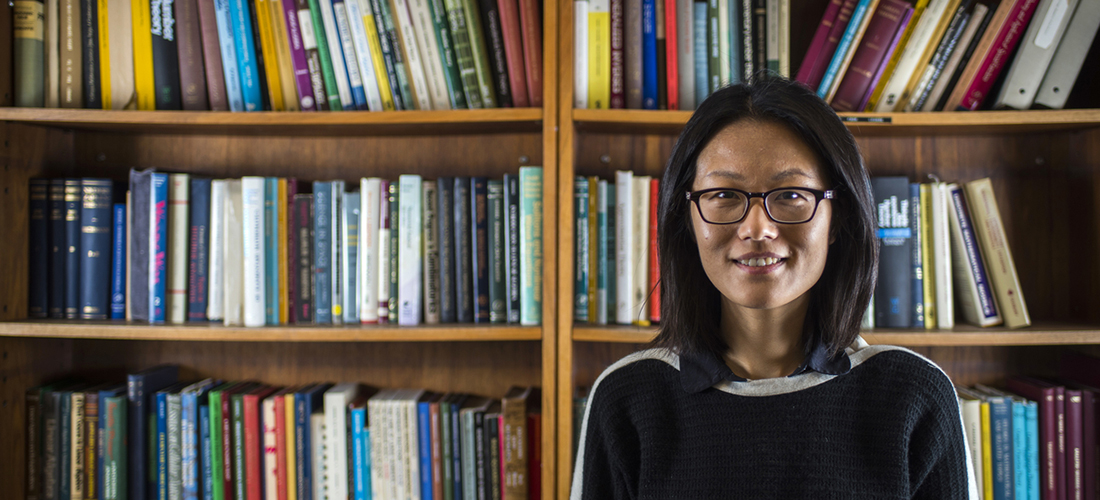
The newest addition to the Department of Mathematical and Statistical Sciences, UAlberta alumna Bei Jiang, is doing research in statistics and statistical analysis to help decipher health data.
After earning her PhD in Biostatistics from the University of Michigan, Faculty of Science alumna Bei Jiang has returned to the Department of Mathematical and Statistical Sciences. Through several collaborations, Jiang is exploring research topics in statistics and statistical analysis to help decipher complex health data.
We sat down with Jiang to learn more about her journey to the U of A and what we can look forward to seeing from her as a newly appointed Assistant Professor.
Q: To start, can you introduce yourself and share some of the accomplishments and highlights from your career up to now?
A: I am an Assistant Professor in the Department of Mathematical and Statistical Sciences, starting in July 2015. I received my PhD in Biostatistics from the University of Michigan (2009-2014) while holding an NSERC PGS D scholarship, an MSc in Biostatistics from University of Alberta (2006-2008), and a BSc in Information and Computing Science from the Beijing University of Technology in China (2000-2004). My research focuses on Bayesian methods, latent variable modelling, statistical imaging analysis, and statistical machine learning. For my PhD research, I worked on latent variable modelling for joint analysis of longitudinal and health outcome data.
Q: What has your academic journey been like so far, and how did it bring you to the University of Alberta?
A: Before joining the University of Alberta in 2015, I was a postdoctoral research fellow jointly at Columbia University and New York University (2014-2015), where my post-doctoral research focused on developing statistical methodology for discovering brain imaging bio-signatures for psychiatric disorders. During both my doctoral and postdoctoral journeys in the U.S., I maintained a good relationship with my former MSc advisor from the U of A and applied for an open position at the U of A without thinking twice. Ultimately, it was my interest in joining the ranks of passionate researchers at University of Alberta that brought me here.
Q: What was it that interested you in coming to the U of A?
A: I studied at U of A for my MSc degree and have always liked the welcoming and collegial atmosphere at the U of A since I was a student. I am also impressed with the academic excellence and the supportive, inspiring, and diversified research environment throughout the department and the university.
Q: What are some current research projects you are working on?
A: My current methodological research focuses on developing statistical methods for brain imaging data with applications in precision medicine and mediation analysis. For example, brain structure, function and connectivity can be easily and quickly measured using Diffusion Tensor Imaging (DTI), Magnetic Resonance Imaging (MRI), functional MRI (fMRI) and Electroencephalogram (EEG). This innovation presents new opportunities to discover promising bio-signatures among complex brain signals that maximize the selection of optimal treatment for individual patients at beginning of treatment as well as identify indicators of eventual treatment outcomes early in treatment. However, statistical methods currently available for this purpose are still inadequate. My research focus is to integrate latent variable/hierarchical modelling and statistical machine learning methods, which could circumvent many of the difficulties typically associated with classical statistical inference.
Q: Now that you have been here for a few months, what you have most enjoyed about your experience at the U of A so far?
A: Researchers from within and outside my fields at the University of Alberta have already contacted me for collaborations on interesting research problems. Besides my independent methodology research, I have always enjoyed working on developing statistical methods inspired by collaborative work. The University of Alberta offers a supportive interdisciplinary environment for discussion and knowledge exchange, which I believe will also help me build my own research program in many meaningful ways.
Q: Any other comments?
A: I am very grateful to the Faculty of Science for reaching out and giving me the opportunity to introduce myself.